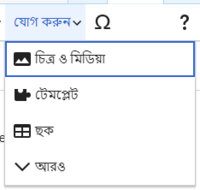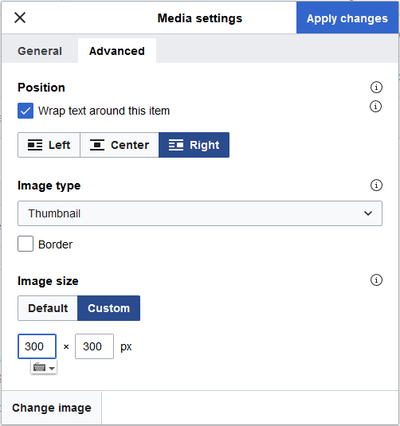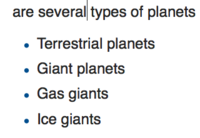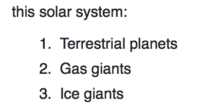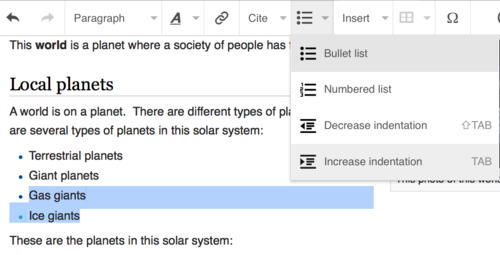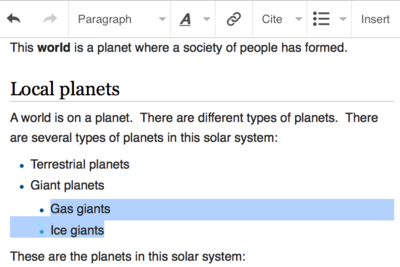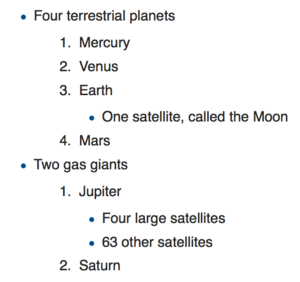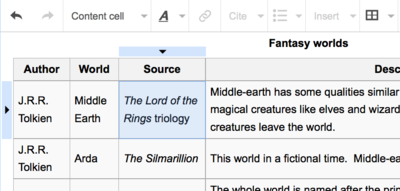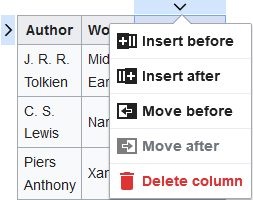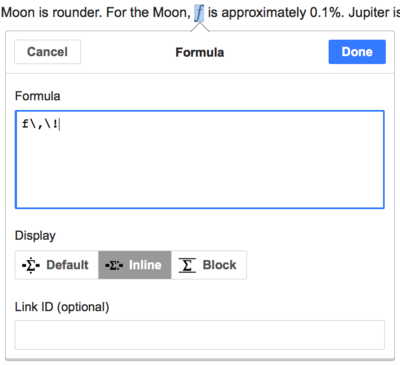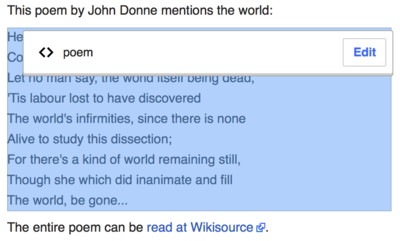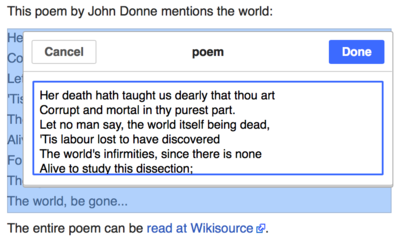সাহায্য:দৃশ্যমান সম্পাদনা/ব্যবহারকারী নির্দেশিকা
| বিঃদ্রঃ যখন আপনি এই পাতা সম্পাদনা করছেন, তখন আপনি আপনার অবদান সিসি০’র অধীনে প্রকাশ করার সম্মতি দিচ্ছেন। আরও তথ্যের জন্য পাবলিক ডোমেইন সাহায্য পাতা দেখুন। |
| VisualEditor portal |
|---|
 |
| সাধারণ |
| বিস্তারিত জানুন |
| চালু করতে সহায়তা করুন |
| যদি আপনি একটি নিবন্ধ সম্পাদনা করা ছাড়া দৃশ্যমান সম্পাদনা ব্যবহার করতে চান তাহলে, এখানে সেই পাতাটি পাবেন যেখানে আপনি অবাধে তা পরীক্ষা করতে পারবেন। সেই পাতায় দৃশ্যমান সম্পাদনা ব্যবহার করার জন্য আপনার একটি অ্যাকাউন্টের প্রয়োজন হবে না। |
দৃশ্যমান সম্পাদনা খোলা
শুরু করার জন্য: দৃশ্যমান সম্পাদনা সরঞ্জামদণ্ড
| ভিজ্যুয়ালএডিটর টুলবার পর্দার উপরের অংশে প্রদর্শিত হবে যখন আপনি ভিজুয়ালএডিটরের মাধ্যমে সম্পাদনা আরম্ভ করবেন। এটি কিছু পরিচিত আইকনসহ: | |
| আপনি যে পরিবর্তন করেছেন তা পূর্বাবস্থা এবং কাজটি পুনরায় করুন করুন। | |
 |
Headings pull-down menu: allows you to change how the paragraph is formatted. To change the style of a paragraph, put your cursor in the paragraph and select an item in this menu (you don't have to highlight any text). Section titles are formatted "শিরোনামা", and subsections are "উপ-শিরোনামা ১", "উপ-শিরোনামা ২", and so on. লেখার জন্য সাধারন বিন্যাসটি হচ্ছে "অনুচ্ছেদ"। |
 |
বিন্যাসন: "A" ক্লিক করার দ্বারা মেনু খুলবে।
If you have not selected any text, then when you press the "A" to open the menu, and then select an item, that formatting will apply to the text that you start typing, from wherever your cursor is located. |
 |
Linking tool: The chain icon is the linking tool. Pressing on it (usually after selecting some text) opens the link dialog. |
 |
উদ্ধৃতি menu: The "উদ্ধৃতি" menu is used to add inline citations (also called "footnotes" or "references"). All projects have access to basic reference formatting and the ability to reuse citations by using this menu. |
 |
উদ্ধৃত করুন বোতাম: If the Citoid service and/or citation tool is enabled on your wiki, you will see a উদ্ধৃত করুন button instead of a উদ্ধৃতি menu.
Instructions for adding local citation templates to the "নিজ হাতে" tab at a specific wiki are available at VisualEditor/Citation tool. Instructions for enabling the স্বয়ংক্রিয় tab are available at Enabling Citoid on your wiki চাইটইয়েড পরিষেবা তথ্যসূত্র টেমপ্লেট স্বয়ংক্রিয়ভাবে পূরণ করার চেষ্টা করে। |
 |
তালিকা এবং ইন্ডেন্টেশন প্রথম দুটি আইকন আপনাকে যথাক্রমে, সংখ্যায়িত অথবা বুলেটকৃত তালিকা তৈরী করতে অনুমতি দেয়। শেষ দুটি আপনাকে বিষয়বস্তুর ইন্ডেন্টেশনের মাত্রা বৃদ্ধি বা হ্রাস করার অনুমতি দেয়। |
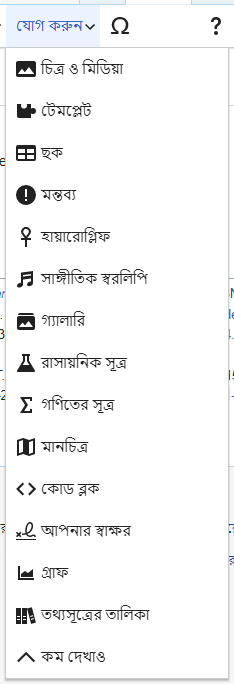 |
মিডিয়া, তথ্যসূত্র এবং অন্তর্ভুক্তি: প্রতিটি আইকন একটি নিয়োজিত ডায়ালগ খোলে:
|
| Special character insertion: The "বিশেষ বর্ণ" (Ω) icon is next to the "যোগ করুন" menu. When pressed, it displays a dialog showing many special characters. By pressing on a specific character, you place it into the text. These special characters include some standard symbols, diacritics, and mathematical symbols. (This list may be customized locally. See VisualEditor/Special characters for instructions.) | |
| সম্পাদনা বিজ্ঞপ্তি বোতাম পাতার জন্য যেকোন বিজ্ঞতি প্রদর্শন করে। | |
 |
The পাতার অপশন menu is to the left of the পরিবর্তন প্রকাশ করুন button and the সম্পাদক পরিবর্তন করুন menu. On this menu there is a button to open an বিকল্পসমূহ dialog with the following (left side) tabs:
The tabs of the বিকল্পসমূহ dialog are also displayed in the পাতার অপশন menu and can be opened by clicking on it. Furthermore the পাতার অপশন menu contains the items বাম-থেকে-ডান হিসেবে দেখুন or ডান-থেকে-বাম হিসেবে দেখুন and the item অনুসন্ধান এবং প্রতিস্থাপন, which opens a bar, where you can insert words or regular expressions you are searching for and those to replace them with, together with several buttons for options. |
| The সম্পাদক পরিবর্তন করুন button is next to the পরিবর্তন প্রকাশ করুন button. It allows you to switch to the wikitext editor. | |
পরিবর্তন প্রকাশ করা
লিঙ্ক সম্পাদনা করা
 |
সরঞ্জামদণ্ডের "লিঙ্ক" আইকনের (একটা চেন সংযোগগুলি) মাধ্যমে লিঙ্ক যোগ করা যেতে পারে, অথবা শর্টকাট Ctrl+K (বা ম্যাকে ⌘ Command+K) ব্যবহার করে।
If you select (highlight) text and then press the "লিঙ্ক" button, that text will be used in creating the link. For a link that involves only one word, you can either select that word or just put the cursor within that word. |
 |
আপনি বাটন অথবা শর্টকাট যাই ব্যবহার করেন, একটি ডায়ালগ খুলবে যেখানে আপনি লিঙ্ক টাইপ করতে পারেন। ভিজ্যুয়ালএডিটর আপনার টাইপে সম্ভবত মিল আছে এমন অভ্যন্তরীণ সংযোগগুলি (উইকিপিডিয়ার অন্যান্য পাতাগুলির লিঙ্ক) খোঁজার দ্বারা সাহায্য করার চেষ্টা করবে।
The link tool will try to help with internal links by searching for likely matches. লিঙ্ক প্রবেশ বা নির্বাচন করার পর, আপনি ↵ Enter টিপতে পারেন, বক্সের বাইরে ক্লিক করুন, অথবা বন্ধ (<) আইকন টিপুন। আপনার লিঙ্ক ভিজ্যুয়ালএডিটর পাতায় প্রদর্শিত হবে, কিন্তু আপনি পাতা সংরক্ষণ করা না পর্যন্ত এটি সংরক্ষিত হবে না। |
 |
To link to a web page on another website, the process is similar: Choose the "বহিঃস্থ সাইট" tab, and enter a URL in the box. |
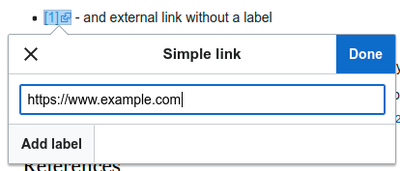 |
লেবেল ছাড়া বহিঃসংযোগ দেখতে এই রকম হবে: [১]। You can add these by placing your cursor away from any word (e.g., after a space). Open the link tool by pressing on the button or pressing the shortcut keys. Type the URL in the box, and press the "সম্পন্ন" button to insert the link. |
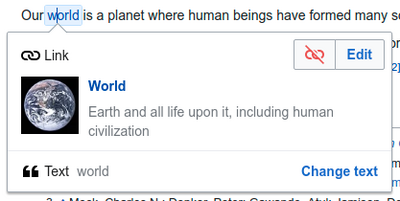 |
To change or remove an existing link, press within the text for that link, then press the "লিঙ্ক" icon that appears near it. The dialog will appear, for editing. You can also get to the dialog with the Ctrl+K keyboard shortcut. When a link is selected, it appears as blue framed.
তারপর আপনি লিঙ্ক -এর লক্ষ্য সম্পাদনা করতে পারেন, অথবা ডায়লগটির উপরের ডান দিকের কোণায় অবস্থিত 'অপসারণ' আইকনে (ট্র্যাশ ক্যান) টিপে সব একসাথে মুছে ফেলতে পারেন। You can also open the link's target in another window by pressing on the copy of the link in the dialog box. (You might want do this to check if an external link is valid.) If you want to exit the link label (the text displayed as a link) or continue to write after this link, you can press →:
To edit the link label of an existing link, press within the link label and type the new one. But if you want to replace the entire label, please note:
|
তথ্যসূত্র সম্পাদনা করা
- আরও তথ্যের জন্য, Help using citation templates or Help using citoid's স্বয়ংক্রিয় tab দেখুন
Determining which system is in place | |
| Your wiki may use one of three footnote systems. The one shown on the right is the simplest system, where the "উদ্ধৃতি" menu does not include any citation templates. If your wiki uses this system, then everything you need to know about footnotes is on this page. |  |
| In the second system, you again start by pressing the উদ্ধৃত করুন button. Then a dialog box opens, which includes several popular citation templates set up for quick access in the "নিজ হাতে" tab. If your wiki uses this system, then you will find more details at Help:VisualEditor/User guide/Citations-Templates |  |
| In the third system, you again start by pressing the উদ্ধৃত করুন button. Then a dialog box opens, which includes an automatic citation process using the citoid service under the Automatic tab. If your wiki uses this system, you will find more details at Help:VisualEditor/User guide/Citations-Full |  |
|
একটি বিদ্যমান তথ্যসূত্র সম্পাদনা করা | |
| To edit an existing reference, press on it where it appears in the text (usually as a bracketed number). You will see either a "তথ্যসূত্র" icon (bookmark) or an icon (and name) for the template that was used to create this reference. In either case, pressing on the "সম্পাদনা" button will open a dialog where you can edit the reference. |  |
| For the "তথ্যসূত্র" icon, pressing "সম্পাদনা" opens the reference dialog. To start changing the reference information, press on it.
অনেক উইকি একটি নির্দিষ্ট মান অনুযায়ী বিন্যাস তথ্যসূত্র টেমপ্লেট ব্যবহার। আপনি যদি একটি বিদ্যমান তথ্যসূত্র সম্পাদন করেন তখন আপনি এটি লক্ষ্য করবেন যার বিষয়বস্তু নীল দেখাবে যখন আপনি এটি নির্বাচন করেন। If a template was used and you press on the reference information, then the টেমপ্লেট icon (puzzle piece) will appear with some information. Press on the "সম্পাদনা" button to edit the content of the template in the template editor dialog. |
 |
| If what appears when you press on a reference is an icon for a standard template for citations (an example is at right), then pressing "সম্পাদনা" will open the template editor dialog. |  |
| Inside the template editor, you can add or remove types of information or change current content. Only fields (template parameters) that have content will show, initially. To add fields, press on "যোগ করুন" at the bottom of the editor. |  |
| কাজ সমাপ্ত হয়ে গেলে "পরিবর্তনসমূহ প্রয়োগ" ক্লিক করুন। | |
একটি বিদ্যমান তথ্যসূত্র পুনঃব্যবহার করা | |
| If the page already contains a citation that applies to the text you want to source, then you can choose to re-use that existing citation.
একটি বিদ্যমান তথ্যসূত্র পুনরায় ব্যবহার করার জন্য, আপনি যে লেখায় এটি যোগ করতে চান সেখানে আপনার কার্সার স্থাপন করুন, এবং টুলবারের "তথ্যসূত্র" আইকনের (বুকমার্ক) উপর ক্লিক করুন। (Note: If your wiki has the second or third footnote system described above, you'll see a "পুনঃব্যবহার" tab, in a dialog, instead of a "পুনঃব্যবহার" item on the "উদ্ধৃতি" menu.) |
 |
| যদি সেখানে অনেক তথ্যসূত্র থাকে, আপনি একটি প্রদত্ত লেখা সাথে মেলার জন্য তথ্যসূত্র প্রদর্শন অনুসন্ধান বার ("আপনি কোন তথ্যসূত্র চান?" লেবেল দেওয়া) ব্যবহার করতে পারেন। |  |
একটি নতুন তথ্যসূত্র যোগ করা | |
| একটি নতুন তথ্যসূত্র যোগ করার জন্য, আপনি যে লেখায় এটি যোগ করতে চান সেখানে আপনার কার্সার স্থাপন করুন, এবং টুলবারের "তথ্যসূত্র" আইকনের (বুকমার্ক) উপর ক্লিক করুন। Then click "মৌলিক". |  |
Using the "মৌলিক" citation | |
| Shown here is what you will see if you select the basic references item. তথ্যসূত্র সম্পাদনায়, আপনি আপনার উদ্ধৃতি যোগ, সম্পাদনা এবং বিন্যাস করতে পারেন।
আপনি তথ্যসূত্র একটি প্রদত্ত দলের অংশভুক্ত করতে পারেন; এটি "তথ্যসূত্রের তালিকা" টুলসহ তথ্যসূত্র দল প্রদর্শন করতে ব্যবহৃত হয়। |
 |
| যদি আপনি একটি নতুন তথ্যসূত্র যোগ এবং এটা একটি টেমপ্লেটের অন্তর্ভুক্ত করতে চাইলে, তথ্যসূত্র সম্পাদনার টুলবারের অন্তর্ভুক্তি আইকনে (ধাঁধার টুকরা) ক্লিক করুন। |  |
| তারপর, আপনি ব্যবহার করতে চান সেই রকম টেমপ্লেটের জন্য দেখুন, এটি যোগ করুন এবং একটি বিদ্যমান যেভাবে সম্পাদনা করে সেভাবে করুন।
তথ্যসূত্র সম্পাদনায় ফিরতে "পরিবর্তনসমূহ প্রয়োগ"-এ ক্লিক করুন এবং মূল সম্পাদনায় ফিরতে আবারও "পরিবর্তনসমূহ প্রয়োগ"-এ ক্লিক করুন। |
 |
| পাতা তে তথ্যসূত্র একটি তালিকা ইতিমধ্যেই উপস্থিত না থাকলে (উদাহরণস্বরূপ, যদি আপনি পাতায় প্রথম তথ্যসূত্র যোগ করেন), প্রদর্শন করতে আপনার তথ্যসূত্র লেখার জন্য অনুক্রমে আপনার এটি যোগ করা প্রয়োজন।
আপনি যেখানে তথ্যসূত্র প্রদর্শন করতে চান সেখানে কার্সার রাখুন (সাধারণত পাতার নীচের অংশে), এবং এটি যোগ করতে "তথ্যসূত্রের তালিকা" আইকনে (তিনটি বই) ক্লিক করুন। |
 |
| আপনি যদি তথ্যসূত্রের দল তৈরি করেন, আপনি বেছে বেছে এটির অন্তর্গত তথ্যসূত্র প্রদর্শনে, এই ডায়লগ বক্সের মধ্যে একটি দল নির্দিষ্ট করতে পারেন।
The final step in the References list dialog is to press "যোগ করুন". |
 |
প্রমিত উদ্ধৃতি টেমপ্লেট ব্যবহার করা | |
| Your local wiki may have added extra citation templates to the "উদ্ধৃতি" menu. If so, you have quick access to the most-used citation templates for your wiki. (Instructions for adding extra citation templates to your local wiki are available at VisualEditor/Citation tool.) |  |
| Pressing on a template icon such as "Cite book" will take you into the template editor for that template. Important information fields may be marked with an asterisk. While the most common fields will be shown, not all of them are required. |  |
| To add more parameters, scroll down in the template editor and press on the "যোগ করুন" option.
Press on "যোগ করুন" when you are done. |
 |
ছবি এবং অন্যান্য মিডিয়া ফাইল সম্পাদনা করা
ছবি আপলোড করা
মিডিয়া গ্যালারি সম্পাদনা করা
টেমপ্লেট সম্পাদনা করা
The powerful MediaWiki template system lets you insert dynamic content, text from other pages, and much more. For a detailed explanation and examples, see the Templates help page.
In the VisualEditor you can search for a relevant template, add an invocation or transclusion on the page you’re editing and, if needed, add custom content using parameters.
Insert new template
| পাতায় একটি নতুন টেমপ্লেট যোগ করার জন্য, আপনি যেখানে টেমপ্লেটটি সন্নিবেশিত করতে চান যেখানে আপনার কার্সার স্থাপন করুন, এবং টুলবারের "সন্নিবেশ" আইকনের (ধাঁধার টুকরা) উপর ক্লিক করুন। Then open the যোগ করুন menu and select " |
 |
| Find the template you want to insert by typing either its name or a relevant keyword. Results containing the search term in either the name or description will display in a dropdown. This should help you find a relevant template, even if you don’t know its exact name.
If you’re having trouble finding the kind of template you want by using keywords, you can look on other wiki pages with similar content and view or edit the page source to see which templates are in use. When you find the desired template’s name, you can type it into this field to insert it here. |
 |
| You can also edit a template that’s already on a page. When you select the template you want to edit, it turns blue, and a box appears displaying " |
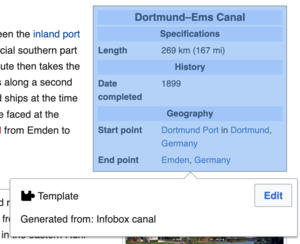 |
| Some templates are not visible to someone reading a page. In the visual editor, such hidden templates are still shown so that you can click and edit or delete them. The name of the template will be shown next to the puzzle icon and both will be grayed out. |  |
|
টেমপ্লেট প্যারামিটার | |
| You’ll see this dialog box when you’re adding a new template or editing one already in place. What you see in the box depends on whether the template in question contains TemplateData, helpful metadata added by other editors to make it easier to edit templates in the Visual Editor.
When a template contains TemplateData, the VisualEditor can use it to present annotated fields for you to fill in.
|
 |
| You can disable any optional parameter (which have blue checkboxes on the left side). If a parameter’s checkbox is grayed out and not clickable, the template requires that parameter, so it can’t be disabled.
When you insert a new template, you may find that some optional parameters are pre-selected. That means the author(s) of the template recommends the use of those parameters. It’s best to review all parameters that will be used in a template to ensure you understand their use. Clicking an unchecked parameter adds it to the template. Clicking a parameter that’s already been added takes you to the parameter’s input field. Some template parameters will show as “deprecated”. Don’t use deprecated parameters when inserting a template; they’re only visible to you because those parameters are in use on older pages where this template was included. |
 |
Adding undocumented parameters | |
| If you’re inserting or editing a template whose author hasn’t laid out its parameters in TemplateData, it has what we call “undocumented” or “unnamed parameters”. In these cases, you should consult the page for the template itself. There you can learn how to correctly employ and work with all of the template’s parameters. This includes learning the exact names of the parameters as written by the template author.
If you find in the documentation that the template expects parameters without names, fill in numbers as placeholders for the parameter names using the undocumented parameter input, then add text to the values you want to provide as you normally would. Example:
If you accidentally include nonexistent, misspelled or erroneous parameters, the values you enter for those parameters won’t show up on the page you’re editing. |
 |
Autogenerated parameters | |
| In this example, the template in question lacks TemplateData but it was possible to autogenerate the parameters. This means that the undocumented parameters have already been added for you, but the names may not be easily understandable and the dialog cannot display any directions or descriptions. As a result the dialog box provides a link to the template’s documentation, which should help you deduce and fill in the template’s various parameters. |  |
Editing multi-part template content | |
| During editing, you may open template content consisting of multiple templates or a single template linked to some wikitext. This differs from the nested templates described below. In this case, the templates are better visualized as being stacked or connected.
This content often contains “unbalanced templates,” templates which are incomplete on their own and need to be paired with some wikitext or another template in order to function. These related pieces of template content must be created in wikitext, but can be edited in the VisualEditor. In these cases you will see a notice at the top of the dialog to signal the situation and a specialized toolbar will be visible at the bottom of the sidebar. There you can use the icon buttons to add additional templates, additional wikitext, delete elements or change their order. |
 |
Nested templates | |
| Templates can include other templates as the value for parameters. You’ll recognize it when you see a parameter whose value contains the double curly braces ( {{ }} ) denoting a template.
The VisualEditor can’t present this template within a template (a nested template) using the editor’s easy-to-use interface, so if you want to nest a template yourself, you’ll need to understand how to add the template by hand in wikitext into the appropriate parameter field. |
 |
Completing your edit | |
| When you have finished editing a template, you can click "পরিবর্তনসমূহ প্রয়োগ". Then you can preview your edit and make sure it looks the way you want and expect.
You may also see an error message, which (like the other TemplateData mentioned above) is community-provided content and may vary in usefulness. You may need to consult the template’s own documentation to get to the bottom of some errors. If you’re still having trouble, consider posting about your problem on the template’s talk page. |
|
Removing a template | |
| To remove a template in the VisualEditor, click the template box. Press the "Delete" or "Backspace" key on your keyboard. The template will disappear from the page. |  |
Editing on mobile | |
| When editing a template on a page using the VisualEditor on a mobile device, you’ll see that the sidebar starts out hidden. You can make it visible by pressing the “Show/hide options” button. |  |
টেমপ্লেট উপকল্পন করা | |
| When you insert a template in a wiki page, its content and appearance are reevaluated every time the page loads, based on the template code and the values of its parameters. This means if someone updates the code of a template, then every page which uses that template will also get updated when they publish.
There’s another, much less common way to use templates, though, and that’s to substitute a template. Doing this permanently includes the template content just as it appears at the moment you insert it. It will not update if the template code is later changed. Most users won’t ever need to resort to substitution. Substitution is typically only useful when you need to capture the exact appearance of one version of a template, such as when content is under development and needs evaluation. To substitute a template in the VisualEditor, insert a template using the name syntax When you’re finished, press “যোগ করুন”, which will insert the template content as you see it. |
 |
Editing lists
ছক সম্পাদনা করা
বিষয়শ্রেণী সম্পাদনা করা
 |
To edit categories, on the "পাতার অপশন" menu, press the "বিষয়শ্রেণীসমূহ" item. |
 |
"বিষয়শ্রেণীসমূহ" বাটন একটি ডায়ালগ খোলে যেখানে বিদ্যমান বিষয়শ্রেণীর তালিকা প্রদর্শন করবে এবং আপনাকে নতুন বিষয়শ্রেণীসমূহ যোগ করতে দিবে।
You also have the option of setting or changing the general (default) sorting key, which determines where the page appears when listed with other pages in the same category. For example, the default sorting key for the article "George Washington" is "Washington, George". In the category "Presidents of the United States", the article is listed under the letter "W", not the letter "G". |
 |
To add a category for a page, type the name of the category into the field "কোনো বিষয়শ্রেণী যোগ". As you type, the visual editor will search for possible matching, existing categories. You can either select an existing category, or you can add a category that doesn't yet have its own category page. (Until that category page is created, your new category will show as a red link after you publish all your editing changes.) |
 |
একটি বিদ্যমান বিষয়শ্রেণী মুছে ফেলার জন্য, এটির উপর ক্লিক করুন এবং প্রর্দশিত ডায়লগ বক্সে "সরান" আইকনের (ট্র্যাশ ক্যান) উপর ক্লিক করুন।
Pressing on a category also allows you to specify a sorting key for that specific category. Such a sorting key overrides the default sorting key. |
| যখন আপনার বিষয়শ্রেণী সম্পাদনা করা সমাপ্ত হবে, তখন মূল সম্পাদনা পাতায় ফিরে যাওয়ার জন্য "পরিবর্তনসমূহ প্রয়োগ"-এ ক্লিক করুন। | |
পাতার সেটিং সম্পাদনা করা
Editing maps
 |
You can add and change maps. See Help:VisualEditor/Maps. |
গাণিতিক সূত্র সম্পাদনা
Editing musical scores
কবিতা এবং অন্যান্য বিশেষ আইটেম সম্পাদনা করা
Switching between the visual and wikitext editors
কীবোর্ড শর্টকাট
অনেক সম্পাদক সরাসরি উইকিটেক্সট প্রবেশ করাতে অভ্যস্ত, বিশেষ করে গাঢ়, ইটালিক এবং উইকিলিঙ্ক। কীবোর্ড শর্টকাট সরঞ্জামদণ্ডের বোতামে ক্লিক না করেও অনুরূপ বিন্যাস দ্রুত সন্নিবেশ করার অনুমতি দেয়। এখানে ভিজ্যুয়াল এডিটরের সাধারণ কিছু শর্টকাট দেয়া হল:
| পিসি শর্টকাট | কাজ | ম্যাক শর্টকাট |
|---|---|---|
| Ctrl+B | গাঢ় | ⌘ Cmd+B |
| Ctrl+I | বাঁকা | ⌘ Cmd+I |
| Ctrl+K | লিঙ্ক সন্নিবেশ | ⌘ Cmd+K |
| Ctrl+X | ছাঁটুন | ⌘ Cmd+X |
| Ctrl+C | অনুলিপি | ⌘ Cmd+C |
| Ctrl+V | প্রতিলেপন | ⌘ Cmd+V |
| Ctrl+Z | পূর্বাবস্থা | ⌘ Cmd+Z |
Also see the full list of all keyboard shortcuts.











